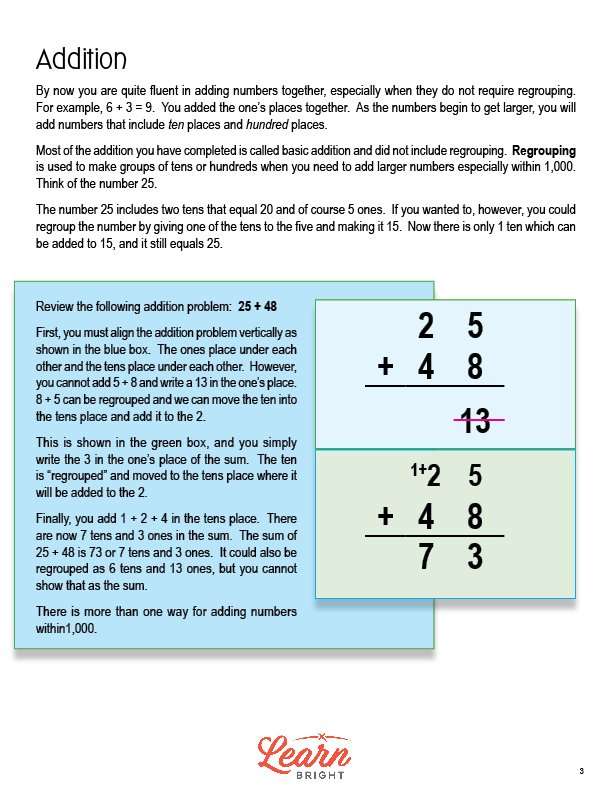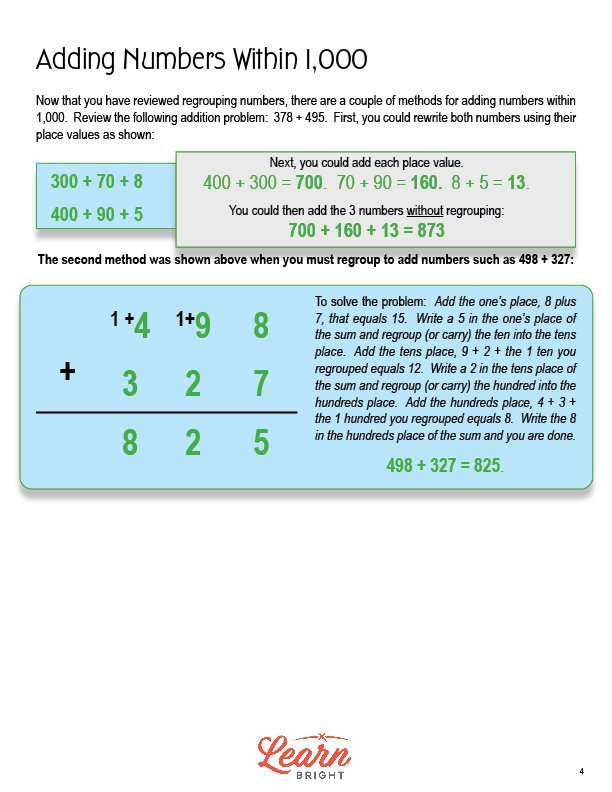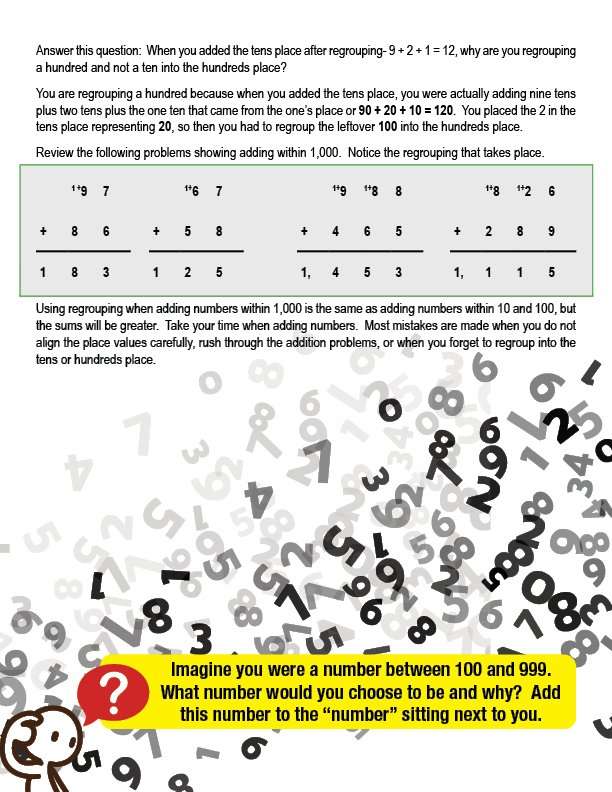Description
What our Adding Within 1,000 lesson plan includes
Lesson Objectives and Overview: Adding Within 1,000 teaches students strategies for the addition of numbers within 1,000. At the end of the lesson, students will be able to fluently add within 1,000 using strategies and algorithms based on place value and properties of operations. This lesson is for students in 3rd grade.
Classroom Procedure
Every lesson plan provides you with a classroom procedure page that outlines a step-by-step guide to follow. You do not have to follow the guide exactly. The guide helps you organize the lesson and details when to hand out worksheets. It also lists information in the blue box that you might find useful. You will find the lesson objectives, state standards, and number of class sessions the lesson should take to complete in this area. In addition, it describes the supplies you will need as well as what and how you need to prepare beforehand. The only supplies you will need for this lesson are scissors and the handouts. To prepare for the lesson ahead of time, you can gather the supplies, pair students for the activity, and copy the handouts.
Options for Lesson
Included with this lesson is an “Options for Lesson” section that lists a number of suggestions for activities to add to the lesson or substitutions for the ones already in the lesson. An optional addition to the activity worksheet is to use dice to create the addition problems. Students can create word problems to match the activity problems they create. They can also add the activity problems using the place value method. Finally, you can have students create a quiz that they can share with the other students in the class.
Teacher Notes
The teacher notes page includes a paragraph with additional guidelines and things to think about as you begin to plan your lesson. It notes that students should come into this lesson knowing their basic addition facts and place value to the hundreds. This page also includes lines that you can use to add your own notes as you’re preparing for this lesson.
ADDING WITHIN 1,000 LESSON PLAN CONTENT PAGES
Addition
The Adding Within 1,000 lesson plan includes three pages of content. The lesson begins by stating that students should be able to add numbers together, especially when they don’t require regrouping. Larger numbers require that you use the tens and hundreds place, instead of just the ones place. Regrouping is when you make groups of tens or hundreds to add larger numbers (in this case, numbers within 1,000). For example, if you have the number 25, you have two tens and five ones. You can regroup this number by adding one of the tens to the five for 15. You would then have 15 and 10. If you add 15 and 10, you get the same number as when you add 20 and 5.
The lesson includes a helpful example problem that it shows you how to solve step-by-step: 25 + 48. The first step is aligning the problem vertically, so you have both the ones and tens places lined up. As always, you start by adding the ones together (5 + 8). However, you can’t write the number 13 in the tens place. Instead, you can use regrouping. To do this, you would write the 3 (the ones place in the number 13) in the ones place and write the 1 (the tens place in the number 13) next to the tens place. You would then add 1 + 2 + 4 in the tens place for a total of 7. Therefore, the answer is 73.
Adding Numbers Within 1,000
There are multiple methods you could use to add numbers within 1,000. The lesson provides the example of 378 +495. You could begin by writing these numbers using their place values: 378 becomes 300 + 70 + 8 and 495 becomes 400 + 90 + 5. You could then add each place value together. 300 + 400 = 700, 70 + 90 = 160, and 8 + 5 = 13. Next, you could add those three numbers together without regrouping: 700 + 160 + 13 = 873. The lesson then shows you how to solve this problem using the method described on the first page of the lesson, where you line up the numbers according to place value and use regrouping to solve.
Something that’s important to note is that when you regroup numbers in the tens place, you regroup it to the hundreds place. For example, if adding 90 + 20 + 10 = 120, you need to remember that you are adding nine tens plus two tens plus one ten for a total of 12 tens, or one hundred and two tens. You regroup that one hundred into the hundreds place. The lesson includes several more examples of this.
When adding larger numbers within 1,000 and using regrouping, you’re using the same method as when you add smaller numbers and regroup. It’s important to practice aligning the place values correctly, as that’s where you’re most likely to make a mistake.
ADDING WITHIN 1,000 LESSON PLAN WORKSHEETS
The Adding Within 1,000 lesson plan includes three worksheets: an activity worksheet, a practice worksheet, and a homework assignment. You can refer to the guide on the classroom procedure page to determine when to hand out each worksheet.
CREATE PROBLEMS ACTIVITY WORKSHEET
Students will work with a partner to complete the activity. They will begin by cutting out and folding each of the numbers on the provided sheet. They will then create three-digit addition problems by randomly selecting numbers, reusing the numbers for multiple problems. Each pair will write down their problems and solve them, showing their work.
Students can work either alone or in groups to complete this activity if you’d prefer.
ADD PRACTICE WORKSHEET
For the practice worksheet, students will solve 30 practice addition problems.
ADDING WITHIN 1,00O HOMEWORK ASSIGNMENT
The homework assignment asks students to complete two short exercises. For the first, they will use the numbers’ place values to solve addition problems, making sure to show their work. For the second, they will read and solve addition word problems.
Worksheet Answer Keys
This lesson plan includes answer keys for the practice worksheet and the homework assignment. If you choose to administer the lesson pages to your students via PDF, you will need to save a new file that omits these pages. Otherwise, you can simply print out the applicable pages and keep these as reference for yourself when grading assignments.









